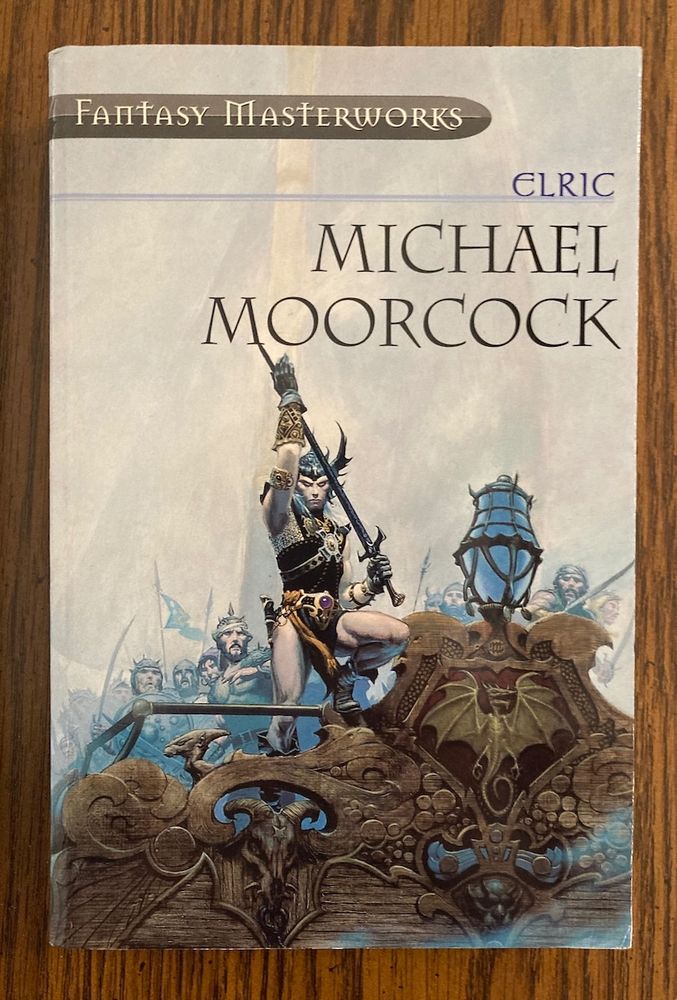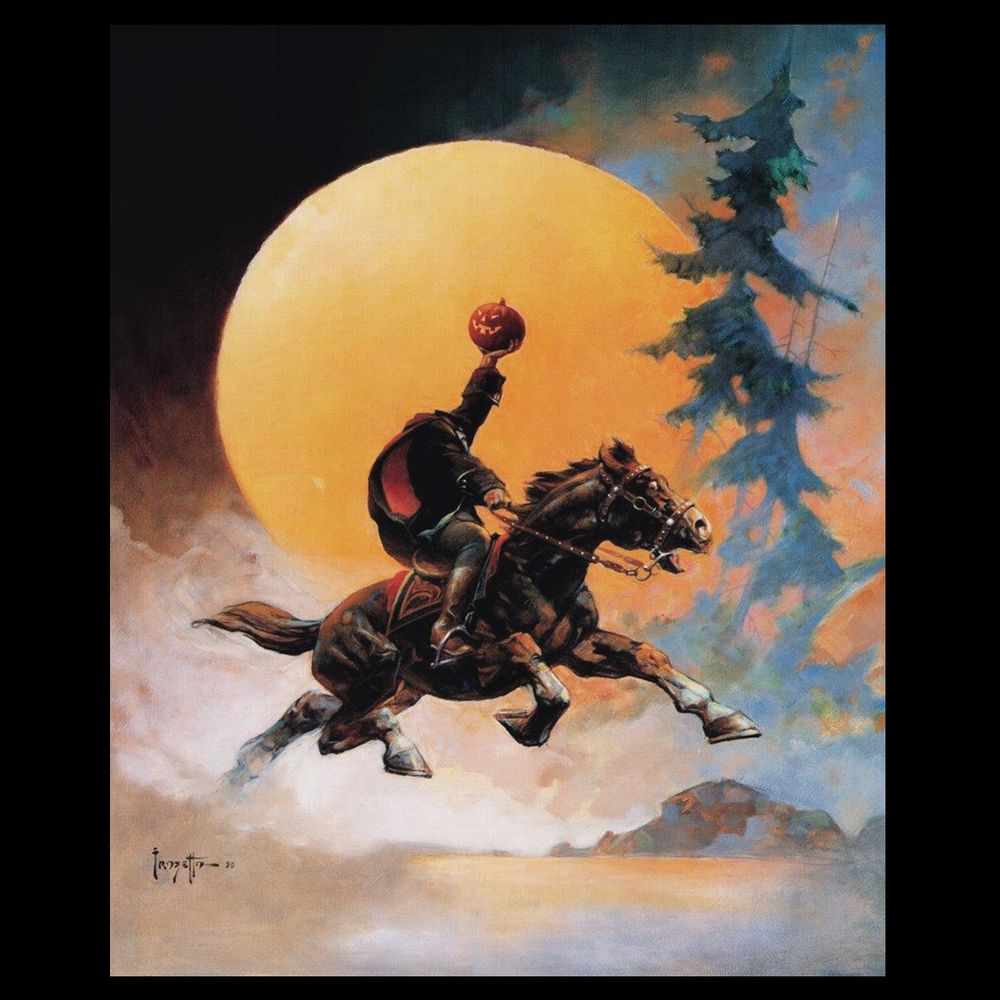
Another interior illustration by Stephen Fabian for the 1977 Underwood-Miller reprint of The Eyes of the Overworld (1966) by Jack Vance. This image is from a book that collects his art. In this scene, a ghostly city and ship full of ghost revelers appeared, then disappeared.

Another interior illustration by Stephen Fabian for the 1977 Underwood-Miller reprint of The Eyes of the Overworld (1966) by Jack Vance. This image is from a book that collects his art. In this scene, a ghostly city and ship full of ghost revelers appeared, then disappeared.
The Seven Geases (1934) by Clark Ashton Smith. An arrogant nobleman on a hunting expedition annoys the wrong sorcerer and is sent as a sacrifice to dwellers below.
Paddock, as used here, is an archaic word for toad.
Tsathoggua idol sculpted by Jason McKittrick.


The Seven Geases (1934) by Clark Ashton Smith. An arrogant nobleman on a hunting expedition annoys the wrong sorcerer and is sent as a sacrifice to dwellers below.
Paddock, as used here, is an archaic word for toad.
Tsathoggua idol sculpted by Jason McKittrick.
Art credit in alt text.

Art credit in alt text.
Two haunted house poems.
Tenant by Frances Angevine Gray. I could not find an original publication date. This text is from Fire and Sleet and Candlelight (1961).
In the Shadows (1935) by Leah Bodine Drake.


Two haunted house poems.
Tenant by Frances Angevine Gray. I could not find an original publication date. This text is from Fire and Sleet and Candlelight (1961).
In the Shadows (1935) by Leah Bodine Drake.
Interior illustration by Stephen Fabian for the 1977 Underwood-Miller reprint of The Eyes of the Overworld (1966) by Jack Vance.

Interior illustration by Stephen Fabian for the 1977 Underwood-Miller reprint of The Eyes of the Overworld (1966) by Jack Vance.
I knew nothing about this movie and just read the short description on a streaming service before watching. I really enjoyed it.

I knew nothing about this movie and just read the short description on a streaming service before watching. I really enjoyed it.

Gnomes (1976 Dutch/1977 English) written by Wil Huygen and beautifully illustrated throughout by Rien Poortvliet. A fascinating field guide to gnomes and similar beings. One of my childhood favorites.

Gnomes (1976 Dutch/1977 English) written by Wil Huygen and beautifully illustrated throughout by Rien Poortvliet. A fascinating field guide to gnomes and similar beings. One of my childhood favorites.
The closing poem of Flower Fables (1854) by Louisa May Alcott. This text is from an 1898 reprint as part of the Altemus' Young People's Library. I don't have a definite credit for the art.


The closing poem of Flower Fables (1854) by Louisa May Alcott. This text is from an 1898 reprint as part of the Altemus' Young People's Library. I don't have a definite credit for the art.


There Will Come Soft Rains (1950) by Ray Bradbury. Published in Collier's. Revised for The Martian Chronicles.
"The five spots of paint—the man, the woman, the boy, the girl, the ball—remained. The rest was a thin layer of charcoal."
The 1918 Sara Teasdale poem central to the story:

There Will Come Soft Rains (1950) by Ray Bradbury. Published in Collier's. Revised for The Martian Chronicles.
"The five spots of paint—the man, the woman, the boy, the girl, the ball—remained. The rest was a thin layer of charcoal."
The 1918 Sara Teasdale poem central to the story:
Fire Demon by Frank Frazetta.
Used as cover art for the 1977 anthology Swords Against Darkness with stories by Robert E. Howard/Andrew J. Offutt, Poul Anderson, George W. Proctor, Bruce Jones, Manly Wade Wellman, Richard L. Tierney, Raul Garcia Capella, David Drake, Ramsey Campbell.

Fire Demon by Frank Frazetta.
Used as cover art for the 1977 anthology Swords Against Darkness with stories by Robert E. Howard/Andrew J. Offutt, Poul Anderson, George W. Proctor, Bruce Jones, Manly Wade Wellman, Richard L. Tierney, Raul Garcia Capella, David Drake, Ramsey Campbell.
This collection of Karl Edward Wagner's early novellas has one story with a werewolf and one with ghouls, ghosts, and a vampire. Plus an excellent quasi-Western, but in a sword-and-sorcery setting.
Art credit in alt text.

This collection of Karl Edward Wagner's early novellas has one story with a werewolf and one with ghouls, ghosts, and a vampire. Plus an excellent quasi-Western, but in a sword-and-sorcery setting.
Art credit in alt text.
Some One (1913) by Walter de la Mare. Text is from Collected Poems (1921). I like to think of this poem as a counterpart to his more well-known spooky poem The Listeners. Which side of the door was the phantom on...🤔

Some One (1913) by Walter de la Mare. Text is from Collected Poems (1921). I like to think of this poem as a counterpart to his more well-known spooky poem The Listeners. Which side of the door was the phantom on...🤔
Strindberg's Ghost Sonata (2008) by Tanith Lee. A very moving novella with a tie-in to August Strindberg's play. A man, saved from suicide, is trapped in the household of his rescuers. His destiny intertwines with that of a ghost woman with a strange and traumatic past.


Strindberg's Ghost Sonata (2008) by Tanith Lee. A very moving novella with a tie-in to August Strindberg's play. A man, saved from suicide, is trapped in the household of his rescuers. His destiny intertwines with that of a ghost woman with a strange and traumatic past.
Oh foolish fire, encased in lantern skin,
Bleed out this night and light my way
With elemental grin.
Reveal the Horns of Deviltry,
Show me the Mask of Death;
I'll gaze beyond the dead-grin glow,
Beyond the dead-leaf flesh.
From: Lantern by Juan J. Gutiérrez
Art credit in alt text.

Oh foolish fire, encased in lantern skin,
Bleed out this night and light my way
With elemental grin.
Reveal the Horns of Deviltry,
Show me the Mask of Death;
I'll gaze beyond the dead-grin glow,
Beyond the dead-leaf flesh.
From: Lantern by Juan J. Gutiérrez
Art credit in alt text.
From a Train Window (1934) by Edna St. Vincent Millay. Text is from Collected Poems of Edna St. Vincent Millay (1990).

From a Train Window (1934) by Edna St. Vincent Millay. Text is from Collected Poems of Edna St. Vincent Millay (1990).
One Night of the Year (1980) by Tanith Lee, who was born on this day in 1947. Cyrion is a sword-and-sorcery character, private detective, and master of disguise. In this story, a family of ghosts lures him into a sepulchre. To survive, he must solve a 1200-year-old mystery.

One Night of the Year (1980) by Tanith Lee, who was born on this day in 1947. Cyrion is a sword-and-sorcery character, private detective, and master of disguise. In this story, a family of ghosts lures him into a sepulchre. To survive, he must solve a 1200-year-old mystery.
The Lord of Cities by Lord Dunsany (1908). Collected in The Sword of Welleran and Other Stories. A rarely mentioned little story with some great passages. Here a spider speaks about the transient nature of humans and all of our works, which it will inherit.

The Lord of Cities by Lord Dunsany (1908). Collected in The Sword of Welleran and Other Stories. A rarely mentioned little story with some great passages. Here a spider speaks about the transient nature of humans and all of our works, which it will inherit.
Lean Times in Lankhmar (1959) by Fritz Leiber. Fafhrd and the Gray Mouser clash when Fafhrd becomes deeply devoted to the obscure god Issek of the Jug, while the Mouser works for a thug extorting priests. A night of drinking and kidnapping ends with an accidental ascension to divinity.


Lean Times in Lankhmar (1959) by Fritz Leiber. Fafhrd and the Gray Mouser clash when Fafhrd becomes deeply devoted to the obscure god Issek of the Jug, while the Mouser works for a thug extorting priests. A night of drinking and kidnapping ends with an accidental ascension to divinity.
The Death of Malygris (1934) by Clark Ashton Smith. A cabal of sorcerers believes that Malygris is dead and seeks to usurp his position. But even in his current state, he demonstrates why he was the most feared sorcerer in Poseidonis.

The Death of Malygris (1934) by Clark Ashton Smith. A cabal of sorcerers believes that Malygris is dead and seeks to usurp his position. But even in his current state, he demonstrates why he was the most feared sorcerer in Poseidonis.
Necromancy in Naat (1936) by Clark Ashton Smith. Zombies, a vampiric demon-weasel, patricide, a wild sword fight, and an operatic finale, all wrapped in beautiful prose. Night Shade restored much of the original text removed by Weird Tales editors.

Necromancy in Naat (1936) by Clark Ashton Smith. Zombies, a vampiric demon-weasel, patricide, a wild sword fight, and an operatic finale, all wrapped in beautiful prose. Night Shade restored much of the original text removed by Weird Tales editors.
The Empire of the Necromancers (1932) by Clark Ashton Smith. The opening paragraph establishes the setting for this first story of Zothique.
In their hubris, two necromancers raise an empire of the dead from the distant past. But the newly arisen have their own prophesy to fulfill.

The Empire of the Necromancers (1932) by Clark Ashton Smith. The opening paragraph establishes the setting for this first story of Zothique.
In their hubris, two necromancers raise an empire of the dead from the distant past. But the newly arisen have their own prophesy to fulfill.
Beyond the Black River (1935) by Robert E. Howard. Frontier story reimagined as sword-and-sorcery in the (fictionalized) Pictish wilderness. Main character is Aquilonian, but the Picts' viewpoint is clearly explained. Dark, gloomy, and thought-provoking, with top-notch action.


Beyond the Black River (1935) by Robert E. Howard. Frontier story reimagined as sword-and-sorcery in the (fictionalized) Pictish wilderness. Main character is Aquilonian, but the Picts' viewpoint is clearly explained. Dark, gloomy, and thought-provoking, with top-notch action.
Opening Door (1959?) by Winifred Adams Burr. Text is from Fire and Sleet and Candlelight (1961). I like the analogy between a poltergeist opening a house door and Burr's imagination opening her mind to new ideas for creative works. She was also a painter.


Opening Door (1959?) by Winifred Adams Burr. Text is from Fire and Sleet and Candlelight (1961). I like the analogy between a poltergeist opening a house door and Burr's imagination opening her mind to new ideas for creative works. She was also a painter.

